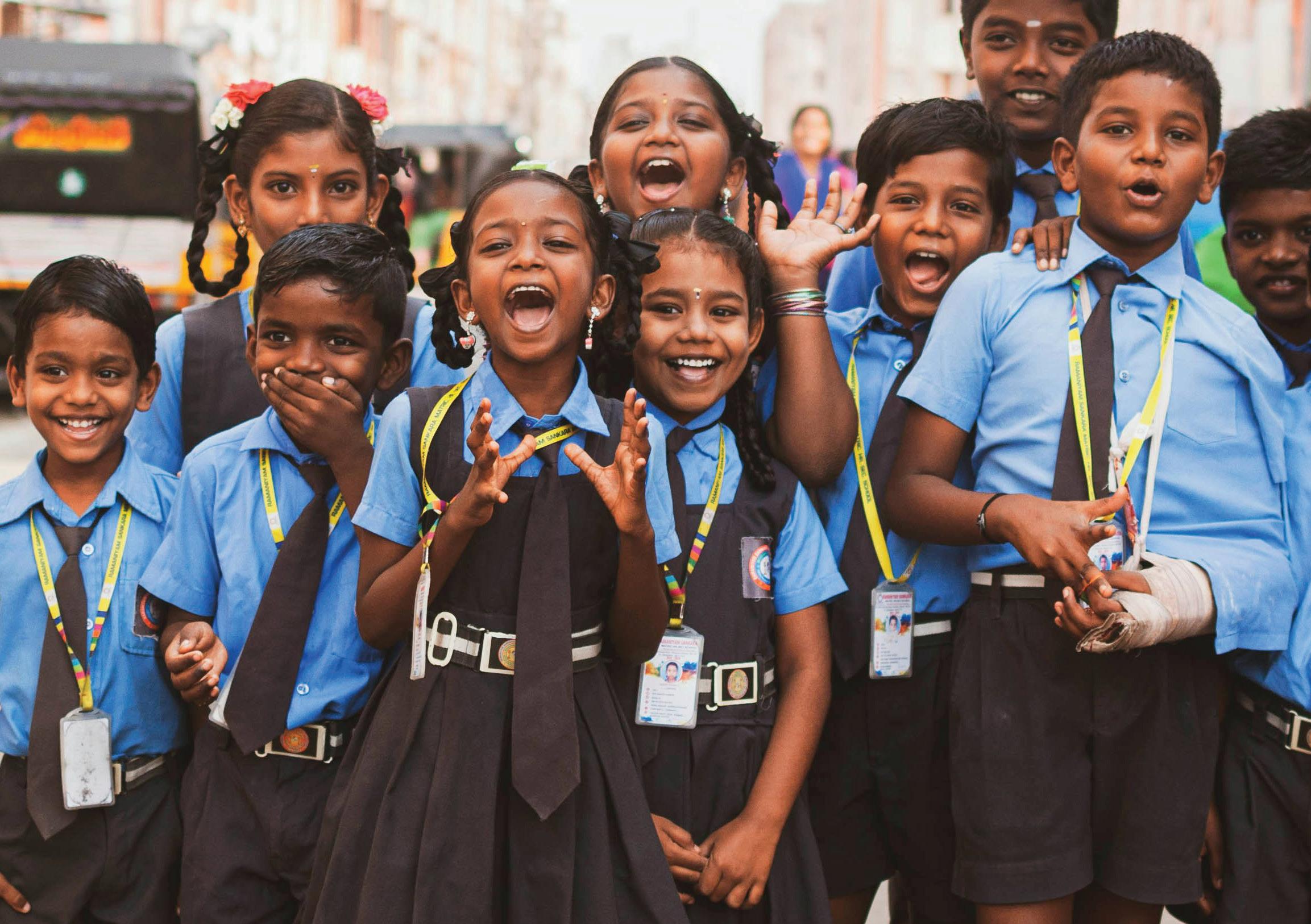

January 2024



January 2024


India’s K-12 education sector, characterised by its diverse array of school types, ownership models, and curricular frameworks, stands as a multifaceted landscape.
Recognising the potential within this dynamic sector, universities are poised to establish a signiicant presence by navigating this diverse landscape. This report serves as a comprehensive guide, delving into the overview of the K-12 landscape in India. This includes an examination of different school types, insights into national educational boards, the rising popularity of
international curricula, the current state of college and career counseling, and viewpoints from schools, counselors, and universities within the evolving K-12 sector and its influence on university outreach.
India’s K-12 education sector is not just a preparatory stage; it is a pivotal gateway to the vast and growing undergraduate student market. By engaging with schools during their senior secondary standards, universities have a unique opportunity to tap into this expansive landscape.
The increasing disposable incomes in middleclass households have contributed to a growing demand for global exposure and international
education, starting at earlier stages of education. Recognising this trend, universities that establish meaningful connections with schools can position themselves as attractive options for prospective undergraduate students. This report highlights the strategic importance of early engagement with the K-12 sector, offering universities valuable insights to leverage the rising demand for study abroad opportunities in India.



India’s education landscape is diverse, with schools categorised by ownership (government, government-aided, private, public, and trust/mission/ foundation-owned), funding, formats (day, day-boarding, residential), and demographic orientations (co-ed, girls-only, boys-only).
In the academic year 2021-22, India witnessed a marginal decrease in the total number of schools from 1,509,136 to 1,489,115.
The overall count of government schools saw a marginal drop of 0.9% between 2021-22, while Private unaided recognised schools registered a moderate annual decline of 2.2%. Residential schools with boarding facilities, however, registered a significant annual increase of 29.8%. Secondary and higher secondary schools offering vocational education under the National Skills Qualifications Framework (NSQF) increased by 7.44%, indicating a growing emphasis on alternative education models in line with the rising emphasis on skill development. Basis the type of school, location, and academic affiliation differences exist in term and annual calendars for schools in different regions within the country.
The majority of the schools in India fall under the umbrella of co-educational schools. Based on the level of education, higher secondary schools are the lowest in number.
Typeofschoolasperstudent population
School as per level of qualification (in thousands)
The Indian school education sector is dominated by four major curriculums: CBSE, CICSE, IB, and CAIE, along with popular boards like NIOS and State boards. The National Institute of Open Schooling (NIOS), under the Ministry of Education, operates as the world’s largest Open Schooling System, offering flexibility in subject choices and online admissions. NIOS has over 2.71 million cumulative enrolments and provides continuous assessment and multiple
chances to complete courses within five years. Additionally, NIOS supports the establishment of State Open Schools (SOSs) in 17 states.
India has 52 state-sanctioned boards, with each state or union territory managing its education department and conducting board exams for classes 10 and 12. Prominent state boards include Maharashtra State Board of Secondary & Higher

Secondary Education (MSBSHSE), Tamil Nadu State Board (TNSB), Uttar Pradesh Madhyamik Shiksha Parishad (UPMSP), Board of Secondary Education Rajasthan (BSER), and West Bengal Council of Higher Secondary Education (WBCHSE) are few names. These state boards are responsible for curriculum development, examinations, and certification, shaping the educational landscape across the diverse regions of the country.
CBSE and CICSE schools in India generally begin the new academic sessions in April, while international curriculum schools follow JanuaryDecember academic sessions. Most schools have summer breaks held between mid-May and June, with schools in hill stations (primarily boarding schools) having winter breaks during December and January. Such months provide international universities seeking to recruit students for undergraduate programmes with a lower opportunity for interactions. Final examinations in CBSE and CISCE schools are conducted in February and March followed by the declaration of results in May. IB examinations are held in November or May and Cambridge examinations, are conducted in March, May, and November, respectively, with results being declared within two months.
Exam Schedule*
Curriculum/ Board
*Internal school examinations may differ in time from school to school and basis region
Fee structures across schools exhibit a wide spectrum in India, influenced by factors such as school type, facilities, curriculum, and location. The expenses for education in India have notably surged, with parents projecting an estimated expenditure of GBP 28,000 (INR 3,000,000) for private schools from the ages of 3 to 17.
GovernmentSchools:
Very nominal; free in certain cases Low
PrivateDaySchools:
GBP 200-2,000 per annum
SpecialisedSchools:
GBP 500-5,000 per annum
Boarding Schools (Residential):
GBP 1,000-10,000 per annum; Higher for elite boarding schools
International Schools:
GBP 2,000-10,000 or more per annum
Central Board of Secondary Education (CBSE) is a government-operated board that adheres to a standardised curriculum across the country. In addition to its network of over 24,000 schools in India (around 21000 schools at senior secondary level), CBSE has nearly 240 schools across 26 countries worldwide. CBSE administers two primary assessments: the All-India Secondary School Examination (AISSE) for students in Class 10 and the All-India Senior School Certificate Examination (AISSCE) for students in Class 12.
Schools affiliated with the CBSE board adhere to the curriculum developed by the National Council of Educational Research and Training (NCERT).
Areas of study at different CBSE school levels include:
• Primary School (up to grade V): Vocabulary and Social Development
• Secondary School (grades VI to X): Science, Mathematics, English and supplementary languages, Arts, Sports, and various other activities
• Senior Secondary School (grades XI and XII): Languages, Humanities, Mathematics, Sciences, Skill, Subjects, General Studies, and Health and Physical Education (seven major learning areas that are broadly divided into electives and compulsory areas).
At both secondary (grade X) and senior secondary levels (grade XII), students are examined by their school’s affiliated board and, if successful, awarded the Secondary School Certificate (SSC) and Higher Secondary Certificate (HSC), respectively. Students who pass the HSC examinations are eligible for university admission.
The Council for the Indian School Certificate Examinations (CISCE) is a privately operated board responsible for administering the three main examinations: the Indian Certificate for Secondary Education (ICSE) examination for Grade 10, and the Indian School Certificate (ISC) and Certificat for Vocational Education (CVE) examinations for Grade 12 students. CISCE is renowned for offering a comprehensive curriculum, which encompasses a diverse array of subjects to deliver a comprehensive and rigorous education. In Grade 12, students can select from a range of diverse streams, including science, arts, and language subjects. The curriculum places a significant emphasis on English language proficiency compared to other educational boards, while also focusing on cultivating students’ analytical abilities.
There are nearly 2,800 schools affiliated with the ISCE board along with around 1600 schools for ISC. The ISC examination is conducted in English, which improves students’ communication abilities and provides additional opportunities for higher education. All candidates eligible to appear are required to appear for English and 3-5 elective subjects examinations. The CISCE offers a range of subjects across humanities, commerce, and science fields.
The CISCE grading system is the same for the ICSE Grade X and ISC Grade XII exams, with slight differences in external examinations and internal assessments based on their subjects.


Over the last 15 years, there has been a tenfold increase in IB schools, with over 700 schools offering international programmes across the country. With the rising interest of students to pursue higher education abroad, the preference for international curricula in schools has evolved from scepticism to active pursuit by parents. Parents now recognise the need for a different learning approach to equip their children for tomorrow’s careers, emphasising critical skills like critical thinking, creativity, and adaptability. This has led to substantial growth in the number of schools offering the International Baccalaureate (IB) and Cambridge curriculum, among others, that focus on developing inquirers, critical thinkers, and compassionate individuals, emphasising skills relevant to an ever-evolving job market. Such curricula help prepare students for the future, encouraging global citizenship and enabling them to compete on a global scale.
The International Baccalaureate (IB) , embraced by 226 schools in India, offers a globally recognised education for globally mobile families through its four programmes: Primary Years Programme (PYP), Middle Years Programme (MYP), Diploma Programme (DP), and Career-related Programme (CP). The IB curriculum promotes well-rounded development, in-depth knowledge, and includes elements like Theory of Knowledge (TOK) and Extended Essay (EA). Globally serving over 3,500 institutions, IB emphasises integrated teaching, comprehensive assessment, academic honesty, and meaningful feedback for holistic student development, making it a preferred choice for preparing confident and globally competent individuals
The number of schools offering International Baccalaureate (IB) increased from 107 in 2013 to nearly 226 in 2023, with an estimated range of 7,000 to 10,000 students across all its programmes (Read more about IB programmes). The IB curriculum covers various subjects, including languages, humanities, sciences, mathematics, and arts with most schools located in metro cities including Maharashtra (Mumbai and Pune), Karnataka (Bangalore), and Telangana (Hyderabad).
In the next five years, the IB plans to expand its presence to over 450 schools in India, establishing 100 new schools offering the Career-related programmeme (CP). The CP, recognised by the Association of Indian Universities, provides a unique blend of academic learning and practical skills, preparing students for future leadership.

Cambridge board refers to the curriculum developed by Cambridge Assessment International Education (CAIE). The qualifying examination under this board is The International General Certificate of Secondary Education (IGCSE, which is an English language-based secondary qualification and is recognised in te UK as being equivalent to the GCSE to recognise prior attainment. Cambridge Advanced provides students with a selection of prescribed textbooks as well as recommended readings.
The examination pattern of the IGCSE is divided into three categories:
• Cambridge Primary is designed for children aged 5 to 11 years.
• Cambridge Secondary 1 is designed for students between the ages of 11 and 14.
• Cambridge Secondary 2 is designed for students between the ages of 14 and 16.
Over the years, the growth of Cambridge schools and students has been significant. From 2015-16 to 2022-23, the total number of Cambridge schools in India increased from 398 to 663, marking a 66% growth. Yearly growth rates varied, with notable jumps in certain years: 38% growth in 2016-17, 44% in 2020-21, and 16% in 2022-23. Student examination entry numbers in Cambridge schools also surged from 21,000+ in 2015-16 to 65,000+ in 2022-23, indicating a 210% increase. Similar to IB, Cambridge schools are also primarily located in metro cities including Maharashtra (149 schools), Tamil Nadu (96), Karnataka (82), and Telangana (66).
Overall, there’s been a consistent upward trend in the establishment of Cambridge schools and enrolment of students in India, showcasing substantial growth, especially in recent years. It provides learners with two options: Cambridge IGCSE and Cambridge O Level. Cambridge Advanced is designed for students between the ages of 16 and 19 who require advanced study in order to adequately prepare for university and higher education. It provides learners with two options: Cambridge International AS and A Level, as well as Cambridge Pre-U.
According to key leaders in India’s K12 education sector, the growth in demand for international curriculum in India is driven by the following factors:
Need for new approaches to learning and teaching. 01: 02: 03:
Framework
To provide a framework that embraces flexibility, liberal choice-making and places a core emphasis on critical thinking skills and global-mindedness.
Demand
Risking demand for a standardised curriculum that is accessible and applicable for applying for higher education in India as well as overseas.
Innovation in Learning and Teaching Approaches
The idea is to offer students a bouquet of options, from which suitable choices can be made as per their learning style and education aspirations… Offering multiple curriculums prepares students to manage the demands of higher education and various disciplines across the country and globally. As a student-centric and friendly institution, making provision of a multi-curriculum school environment helps in catering to students of diverse learning needs and creates a dynamic peer group for interaction, honing perspectives and skills!
 Ms. Manika Sharma Director-The Shri Ram Schools, Delhi-NCR
Ms. Manika Sharma Director-The Shri Ram Schools, Delhi-NCR
In light of globalisation and the increasing relocation of families worldwide, the demand for a curriculum accessible across different countries and standardised across borders has become imperative. Beyond merely offering a standardised outline, an international curriculum plays a crucial role in cultivating a sensitised global perspective and mindset—an essential asset for the success of students in our rapidly evolving and interconnected world.

Ms. Shivangi Panchal
Executive Director (Administration) & College Counselor, Ahmedabad International School
International curriculums focus heavily on the application of knowledge, moving beyond acquisition or possession of knowledge as that is fast changing. Such curricula effectively develop a sense of curiosity and purpose in young lives; and build situational awareness sensitising students about the world. With globalisation, the interest in international curricula and global education is on the rise.Interesting times lie ahead in education in India as the NEP implementation takes shape, aligning with the needs of the future as well as global standards.

Principal-Indus International School, Bangalore
 Ms. Sarojini Rao
Ms. Sarojini Rao



The impact of counsellors on students and parents is significant despite the challenges of access and availability.
According to the IC3 Institute Student Quest report 2023, around more than 86% rated the usefulness of their conversations to be moderately or significantly useful. The areas where counsellors were consdered most helpful were analysing personal strengths and weaknesses (61.9%), shortlisting universities and courses (50.1%), and profile builing (41.6%).
Among essential information that parents are looking for in university interaction are: academic programme, details (18.6%), potential job opportunities (15.6%), safety (11.4%), and ranking (11.3%). In India, the scarcity of career counsellors in schools presents a unique challenging opportunity for university representatives to shoulder the responsibility of being sources of authentic and reliable information; supporting informed decision-making.
The graph above depicts the India student enrollment trends in the United States, United Kingdom, Australia, and Canada over a five-year period from 2017-18 to 2021-22. The US experienced a slight fluctuation during the post-COVID era, while the UK experienced consistent growth, nearly tripling its numbers between 2018 to 2022. Australia saw a steady increase until 2019-20, with
Source: Govt websites of each country
a slight dip in 2020-21, and Canada demonstrated a consistent upward trend throughout the period. Notably, Canada experienced substantial growth, nearly doubling its enrollment from 109,290 in 2017-18 to 232,640 in 2021-22. According to the Indian Student Mobility Report 2023, an analysis conducted by University Living, Beyond Beds and Boundaries, it is projected that the enrollment of
Indian students in overseas educational institutions will increase from approximately 1 million in 2019 to potentially 2 million by the year 2025. According to the research reports, top States in India in terms of students going abroad include – Punjab, Haryana, Andhra Pradesh, Telangana, Kerala, Maharashtra, Delhi/NCR and Tamil Nadu.
Recent trends indicate a shift among Indian students studying abroad, with a significant increase in undergraduate course applications, which have surged two-and-a-half times in the last 12 months, although post-graduate degrees continue to dominate. The US market has seen an 18-20% increase in UG students’ recruitment whereas the UK has seen up to 50% increase in UG recruitments in the last 5 years.
Schools and students in India often look for value-add that universities can provide, in addition to the core curriculums offered.
Based on our interactions with Khushboo Taparia Bedi, Career Cell Coordinator at The Sanskaar Valley School, Bhopal, it was found that universities need to have a vision to impact different stakeholders in the school ecosystem to have their presence felt within the Indian school community. Different ways in which a university can do so with various K12 sector stakeholders are listed below:
• Senior Management Team (SMT) – Providing leadership training programmes for senior management. Additionally, representatives from the University can be on the advising board of the school to educate and support the SMT in planning the smooth transitioning of students from school to university, sharing new trends in education regularly, etc.
• Students – Providing knowledge sessions, current students and alumni sharing their
experiences, scholarships, hand holding with application and visa processes, application fee waiver for counsellor recommend students (~5 in a year), research opportunities for students by offering Professor support, creating internship opportunities and running experiential workshops with certifications, and assigning student mentors from the university.
• Career Counsellors – Enabling counsellors to recommend ~5 students for scholarships from the school, providing SPOC for any application and visa support required, and attending important conferences and career fairs with counsellors to provide them with knowledge, experience, and exposure.
• Parents - Parents will be happy to see how their students are supported by the university!!
• Teachers – Establish ways of aiding and empowering teachers at Indian schools so they may also help students with career counselling in their subject area, if required.
Beyond academia and university awareness programmes, universities can also perform a prior need analysis of what parents need to empower them for being able to better support their ward in career planning and decisions.
 Khushboo Taparia Bedi
Khushboo Taparia Bedi
Based on our interactions with Ramya Modukuri, Director of Future Pathways, IndiaInternational Schools Partnership it was found that Universities can offer invaluable collaboration opportunities for schools that extend beyond the conventional admissions support provided to school counsellors. This partnership could encompass a multifaceted approach to education enrichment, including guest lectures by university faculty for students and parents that shed light on the academic discipline, pursuing the subject at university level, career paths and cutting-edge developments within the respective fields. This can be supplemented by contributing to professional development of educators/ teachers by conducting leadership or industry-related workshops, enhancing their skills and knowledge to equip for higher quality student engagement.
The collaboration should involve engaging admissions-related sessions designed to be interactive and enjoyable for students and high school counsellors. For instance, some sessions simulate a mock admissions-review workshop led by a U.S. university, allowing students to assess applicant profiles actively. Other sessions may include portfolio-development workshops or interactive essay workshops, providing students with the opportunity to brainstorm topics and actively participate in the learning process, useful in self-discovery and truly unpacking ‘best-fit’ choices. To offerall these different and meaningful types of engagements, it is critical for the universities or incountry representatives to be contextually aware and really know the needs of the community, through interactions with the school.
 Ramya Modukuri Director of Future Pathways
Ramya Modukuri Director of Future Pathways
Acumen, in its conversations with various university outreach professionals observed there to be certain trends regarding Indian schools’ collaboration with local and international universities. These include:
• Rise in the number of university fairs and events across the country
• Schools proactively reaching out to universities for participation in university fairs
• Universities travelling in groups/ as consortiums to visit school campuses and events, which ultimately helps in optimising time for both schools and universities
• A greater focus by universities towards building an in-depth cultural understanding of their region or market that can support in undertaking the student context and motivation into consideration
• Working closely in/ with governmentsupported initiatives has proven to be beneficial in building the perspective of universities’ region as a study destination visà-vis just an immigration destination
• Shift from transaction-based outreach to value addition and counselling-based outreach initiatives, which include richer and more meaningful engagement instead of only university-specific informatio
• Students and parents in India are much more informed and involved in the college application process than before and seek a counselling-based approach to university conversations, wherein all the pros and cons about the destination country are transparently discussed and matched with the needs of the students to understand the ‘right fit approach
• Details regarding the cost of living, availability/ lack of scholarships, changing of postwork working rights rules, and employment opportunities post-course completion are key areas that students and parents seek responses to at outreach engagements.

I have seen a cultural shift in schools becoming more proactive and open, more schools with counsellors, this has allowed us to have more sessions with students around myths, engagement in activities, storytelling for their application essays and how all of this comes together. Being naturally curious paved the way for me to learn and strengthen my understanding of India, students and families and school systems in this region. For making an impact as a university outreach professional/recruiter an important tip is to bring maximum lived experiences to interactions with families and counsellors and this is best done if you keep in touch with current students at the university.
 Julie Chiu
Julie Chiu
University of Southern California, USA
Outreach has evolved organically over the last decade to include much more than a sales pitch to some of the top high schools in metro cities. No one wants to sit through another 30-minute PowerPoint presentation! It is now about equitable access, relationship building between counsellors and university of�cers, collaborating with the schools in creating awareness about study destinations, new courses, and career options, delivering academic workshops as tasters to university life, counsellors and teacher training initiatives to share some of the best practices, and encouraging a two-way exchange of ideas and knowledge. However, as any ‘outreach’ professional will vouch, the toughest part remains to establish that first connection at any school which opens te doors for them.
 Anuradha Gupta
Anuradha Gupta
Higher Education expert, ex-Macquarie University, Australia
The university had comprehensive school connections even before it started with the basecamp office in the country, primarily wthin international schools. The office in India therefore made conscous efforts to reach out to more Indian curriculum schools and also gradually expand its presence into tier 1 and tier 2 cities. Going into schools and interacting with educators has been a great learning experience that has helped in approaching conversations with students and their families more effectively.
 Tanushree Bhattacharya
Tanushree Bhattacharya
University of British Columbia, Canada
In times when school calendars are shrinking with availability and school counsellors/ principals are being bombarded with a significant increase in outreach proposals, ‘Collaboration’ has emerged as a key theme to effectively execute our outreach initiatives, and the UK has certainly established consortiums (long term as well as project-based university groups) to promote this and many more are in the talks of being formed.
 Palak Behl
Palak Behl
King’s College London, United Kingdom


Acumen is committed to helping globally — ambitious universities and broader education service providers enter, explore, and expand in South Asia, Southeast Asia, and beyond.
Acumen offers a dedicated range of services to drive student recruitment and enrolment; develop strategic partnerships; and deliver consulting based on individual partner needs. As a result, Acumen acts as an extension of your brand, connecting you with students, unlocking strategic international education opportunities, understanding your ideal market through research and insights, and helping to mitigate risks along the way.
We have developed robust partnerships with stakeholders across the globe, including government agencies in Australia, Canada, India, Ireland and New Zealand, as well as US International Trade Administration, the US Department of Commerce and the UK Department of International Trade.
We operate in over 20 countries, with more than 250 industry practitioners with deep local knowledge and global expertise. We help our partners navigate a competitive education landscape from end to end, while always prioritising their success.




